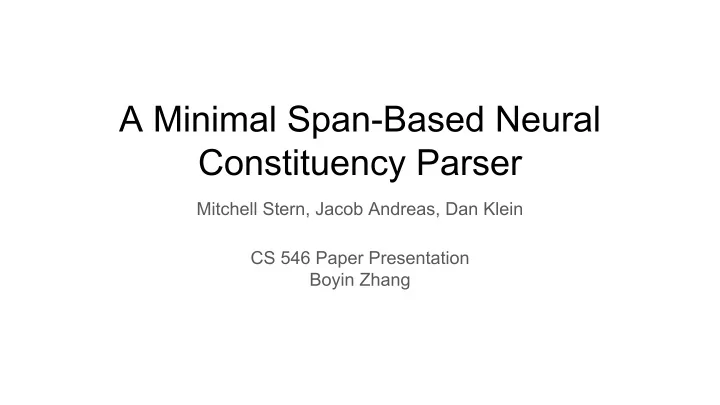

A Minimal Span-Based Neural Constituency Parser Mitchell Stern, Jacob Andreas, Dan Klein CS 546 Paper Presentation Boyin Zhang
Outline 1. Introduction 2. Background 3. Model 4. Algorithms 5. Training Details 6. Experiments 7. Conclusion
Intro: Overview This paper: ● constituency parsing ● a novel greedy top-down inference algorithm ● independent scoring for label and span The goal is to preserve the basic algorithmic properties of span-oriented (rather than transition-oriented) parse representations, while exploring the extent to which neural representational machinery can replace the additional structure required by existing chart parsers.
Intro: Penn Treebank ● The first publicly available syntactically annotated corpus ● Standard data set for English parsers ● Manually annotated with phrase-structure trees ● 48 preterminals (tags): ○ 36 POS tags, 12 other symbols (punctuation etc.) ● 14 nonterminals: standard inventory (S, NP, VP,...) ● Dataset for this paper
Intro: Constituency Parsing
Intro: Span and Label span(0, 5) represent the full sentence, with label S.
Intro: Hinge Loss In machine learning, the hinge loss is a loss function used for training classifiers. The hinge loss is used for "maximum-margin" classification, most notably for support vector machines (SVMs). [1]
Background: Transition Based Parser ● Do not admit fast dynamic programs and require careful feature engineering to support exact search-based inference (Thang et al., 2015) ● Require complex training procedures to benefit from anything other than greedy decoding (Wiseman and Rush, 2016)
Background: Chart Parser ● Require additional works, e.g, pre-specification of a complete context-free grammar for generating output structures and initial pruning of the output space ● Do not achieve results competitive with the best transition-based models.
Algorithm: Chart Parsing The basic model, compatible with traditional chart-based dp algorithms. Use modified CKY recursion to find the tree with highest score. O(n^3).
Model: Span Representation : f 5 -f 3 b 3 -b 5 span(3,5)
Model: Scoring Functions
Algorithm: Chart Parsing ● base case: ● score of the split (i, k, j) as the sum of its subspan scores: ● joint label and split decision:
Algorithm: Chart Parsing Finally, s_best(0, 5). e.g. s best (1, 4) : [(1, 2) (2, 4)]; [(1, 3) (3, 4)]; = max[s label (1,4)] + max[(s best (1, 2)+s best (2, 4)+s span (1, 2)+s span (2, 4)), (s best (1, 3)+s best (3, 4)+s span (1, 3)+s span (3, 4))]
Algorithms: Top-Down Parsing At a high level, given a span, we independently assign it a label and pick a split point, then repeat this process for the left and right subspans. ● base case: ● label and split decision :
Algorithms: Top-Down Parsing
Training: Loss Functions For a span (i, j) occurring in the gold tree, let l* and k* represent the correct label and split point, and let and be the predictions made by computing the maximizations ● Hinge loss for label: ● Hinge loss for split:
Training: Alternatives ● Top-Middle-Bottom Label Scoring ● Left and Right Span Scoring ● Span Concatenation Scoring ● Deep Biaffine Span Scoring ● Structured Label Loss
Training: Details ● Penn Treebank for English experiments, French Treebank from the SPMRL 2014 shared task for French experiments. ● a two-layer bidirectional LSTM for our base span features. Dropout with a ratio selected from {0.2, 0.3, 0.4} is applied to all non-recurrent connections of the LSTM ● All parameters (including word and tag embeddings) are randomly initialized using Glorot initialization ● Adam optimizer with its default settings ● implemented in C++ using the DyNet neural network library (Neubig et al., 2017).
Evaluation Metric: F1 score ● The traditional F-measure or balanced F-score ( F 1 score ) is the harmonic mean of precision and recall
Results Processing one sentence at a time on a c4.4xlarge Amazon EC2 instance: ● Chart parser: 20.3 sens/s ● Top-down: 75.5 sens/s
Conclusion Span-Based Neural Constituency Parser ● bi-LSTM for span representation ● dynamic programming chart-based decoding ● a greedy novel top-down inference procedure ● NN methods works
Recommend
More recommend